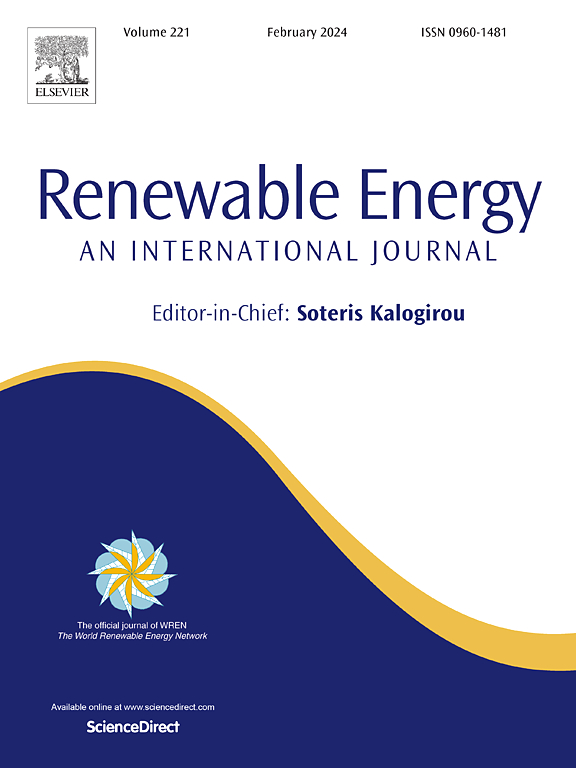基于声发射的风力发电机叶片结冰深度学习监测
IF 9
1区 工程技术
Q1 ENERGY & FUELS
引用次数: 0
摘要
风力涡轮机叶片结冰严重影响风能系统的效率、安全性和可持续运行。然而,现有的叶片结冰监测方法存在响应延迟、精度低、环境干扰和气动性能受损等局限性。尽管声发射(AE)技术在风力涡轮机叶片裂纹和分层等结构健康监测中已经证明了其有效性,但本研究试图通过引入一种新型的叶片结冰实时监测系统来扩展其应用范围。通过理论分析,本研究揭示了叶片在结冰过程中,特别是在初始结冰和最终融化阶段,由于叶片旋转过程中离心力、气动载荷和重力引起的应力变化而产生声发射信号。声阻抗分析进一步表明,由于冰与叶片材料之间的声阻抗特性相似,声发射信号可以有效地从冰层传递到内部传感器,验证了内壁传感器放置的可行性。设计了一个小型实验系统,用于在正常运行、结冰和下雨条件下收集声发射信号。时频域分析揭示了明显的频谱特征——结冰条件在147khz - 190khz波段有显著的峰值,而降雨信号则集中在6khz - 9khz的低频区域。采用辛几何模态分解(sggmd)对信号进行处理,设计了SGC1和SGC2分量相结合的最优重构方案,在降低噪声干扰的同时,有效地保留了信号的关键特征(相关系数大于0.95,幅度保持率大于90%)。各种深度学习模型,包括卷积神经网络、长短期模型和Transformer网络的两个版本,被用于状态识别。结果表明,它们的平均识别准确率均超过99.5%,标准差小于0.001。变压器模型的精度达到99.89%,计算效率达到0.09 s·epoch−1。该方法有效地解决了现有监测方法的关键局限性,实现了早期检测,避免了空气动力学干扰,可靠地区分了结冰和环境干扰,为提高风电场的运行安全性和经济效益提供了一种创新的技术解决方案。本文章由计算机程序翻译,如有差异,请以英文原文为准。
Acoustic emission-based wind turbine blade icing monitoring using deep learning technology
Blade icing on wind turbines can significantly affect the efficiency, safety, and sustainable operation of wind energy systems. However, the existing blade icing monitoring methods face certain limitations, such as delayed response, low accuracy, environmental interference, and compromised aerodynamic performance. Although acoustic emission (AE) technology has demonstrated its effectiveness in structural health monitoring of wind turbine blades such as crack and delamination, this study attempts to extend its application by introducing a novel real-time monitoring system for blade icing detection. Through theoretical analysis, this study reveals that acoustic emission signals are generated during blade icing process, particularly at the initial icing and final melting stages, due to stress variations caused by centrifugal force, aerodynamic load, and gravity during blade rotation. The acoustic impedance analysis further demonstrates that these AE signals can be effectively transmitted from ice layer to internal sensors owing to the similar acoustic impedance characteristics between ice and blade materials, validating the feasibility of internal wall sensor placement. A small-scale experimental system is designed to collect acoustic emission signals under normal operation, icing, and rainy conditions. The time-frequency domain analysis reveals distinct spectral characteristics - icing conditions show significant peaks in the 147 kHz–190 kHz band, whereas rain signals are concentrated in the low-frequency region of 6 kHz–9 kHz. The symplectic geometry mode decomposition (SGMD) is employed for signal processing, and an optimal reconstruction scheme combining the SGC1 and SGC2 components is designed, effectively preserving the key signal features (i.e., the correlation coefficient of more than 0.95, and the amplitude retention rate higher than 90 %) while reducing noise interference. Various deep learning models, including the convolutional neural network, long-short term model, and two versions of the Transformer network, are employed for state recognition. The results indicate that they can all achieve average recognition accuracy exceeding 99.5 % with a standard deviation below 0.001. The Transformer model demonstrates superior performance over the other models, with 99.89 % accuracy and a high computational efficiency of 0.09 . This method effectively addresses key limitations of existing monitoring approaches by enabling early detection, avoiding aerodynamic interference, and achieving reliable discrimination between icing and environmental interference, providing an innovative technical solution for enhancing wind farm operational safety and economic benefits.
求助全文
通过发布文献求助,成功后即可免费获取论文全文。
去求助
来源期刊

Renewable Energy
工程技术-能源与燃料
CiteScore
18.40
自引率
9.20%
发文量
1955
审稿时长
6.6 months
期刊介绍:
Renewable Energy journal is dedicated to advancing knowledge and disseminating insights on various topics and technologies within renewable energy systems and components. Our mission is to support researchers, engineers, economists, manufacturers, NGOs, associations, and societies in staying updated on new developments in their respective fields and applying alternative energy solutions to current practices.
As an international, multidisciplinary journal in renewable energy engineering and research, we strive to be a premier peer-reviewed platform and a trusted source of original research and reviews in the field of renewable energy. Join us in our endeavor to drive innovation and progress in sustainable energy solutions.
 求助内容:
求助内容: 应助结果提醒方式:
应助结果提醒方式:


